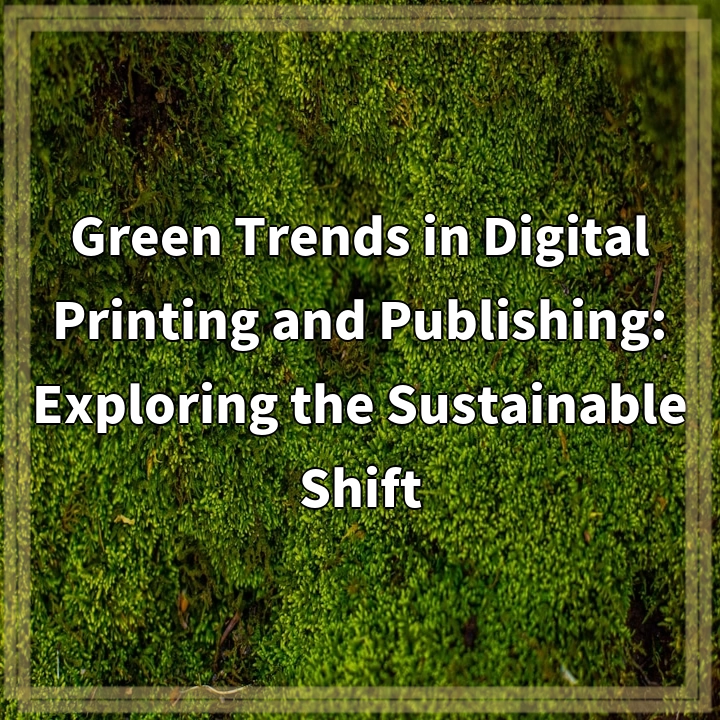
What it is:
Digital printing and publishing have brought about a significant shift in the way content is created, distributed, and consumed. This technological advancement has not only revolutionized the publishing industry but also opened up new opportunities for sustainability. Green trends in digital printing and publishing involve adopting environmentally-friendly practices and utilizing sustainable alternatives to traditional printing methods.
Real-world problems:
1. Paper waste:
One of the prominent challenges in traditional printing is the significant amount of paper waste generated. Printing large volumes of materials often results in unused or outdated copies, leading to environmental degradation. Digital printing provides a more sustainable solution by eliminating excessive paper consumption and reducing overall waste.
2. Chemical usage:
Traditional printing involves the use of various chemicals like inks, solvents, and cleaning agents, which can have harmful effects on the environment. These chemicals can contaminate soil and water systems, leading to pollution. On the other hand, digital printing significantly reduces chemical usage, minimizes the release of toxic substances, and helps protect the ecosystem.
3. Energy consumption:
Conventional printing processes require large-scale machinery and equipment that consume significant amounts of energy. This energy reliance contributes to carbon emissions and increases the ecological footprint. Digital printing, on the other hand, utilizes energy-efficient printers and reduces energy consumption, making it a more sustainable option.
4. Transportation impact:
Traditional publishing often involves extensive transportation of printed materials from the printing facility to various distribution points. This transportation contributes to greenhouse gas emissions and air pollution. With digital publishing, content can be distributed electronically, eliminating the need for physical transportation and reducing carbon emissions associated with logistics.
5. Biodiversity preservation:
The paper production industry often leads to deforestation, which has detrimental effects on biodiversity. By adopting digital printing and publishing, the demand for paper decreases, reducing the need for logging and helping in the preservation of forests and wildlife habitats.
6. e-Waste management:
While digital printing and publishing offer sustainable advantages, it is crucial to address the issue of electronic waste (e-waste). Proper disposal and recycling of electronic devices become paramount to prevent environmental pollution. Manufacturers and users must prioritize responsible e-waste management to maximize the sustainability potential of digital printing practices.
In summary, embracing green trends in digital printing and publishing can lead to significant sustainability benefits by minimizing paper waste, reducing chemical usage, conserving energy, limiting transportation impact, preserving biodiversity, and addressing the e-waste issue. These trends present opportunities for the industry to shift towards environmentally-friendly practices and contribute to a more sustainable future for the publishing and printing sectors.

Solutions to Green Trends in Digital Printing and Publishing:
Implementing sustainable practices in digital printing and publishing can address the real-world environmental challenges mentioned in the previous section. Here are some solutions to promote a more sustainable shift in the industry:
1. Paper waste reduction:
– Opt for digital formats whenever possible to minimize the use of paper.
– Encourage digital readership and e-publishing platforms to reduce physical printing needs.
– Implement print-on-demand strategies to avoid excess printing and reduce paper waste.
2. Chemical usage optimization:
– Choose eco-friendly and low-VOC (volatile organic compounds) inks and solvents for digital printing.
– Use non-toxic cleaning agents and adopt responsible chemical management practices.
– Support manufacturers that prioritize sustainable ink and toner production.
3. Energy-efficient processes:
– Invest in energy-efficient printing equipment and technology.
– Implement power-saving features and consider renewable energy sources in printing facilities.
– Reduce idle time and optimize production schedules to minimize unnecessary energy consumption.
4. Digital distribution:
– Embrace digital publishing platforms and explore e-reader options to distribute content electronically.
– Utilize cloud storage and online sharing platforms for efficient content dissemination.
– Encourage readers to switch to digital subscriptions and promote “paperless” reading habits.
5. Forest preservation:
– Promote responsible paper sourcing by opting for recycled or sustainably harvested paper.
– Engage in reforestation initiatives and support organizations that focus on forest conservation.
– Raise awareness about the link between paper consumption and deforestation to encourage nature preservation.
6. E-waste management:
– Encourage proper recycling and disposal of electronic devices used in digital printing and publishing.
– Support e-waste collection and recycling programs to minimize environmental pollution.
– Collaborate with manufacturers to improve device design for better recyclability and reduced material waste.
By implementing these solutions, the digital printing and publishing industry can make significant strides towards a more sustainable future, reducing its environmental footprint and contributing to global efforts in combating climate change and preserving natural resources.















